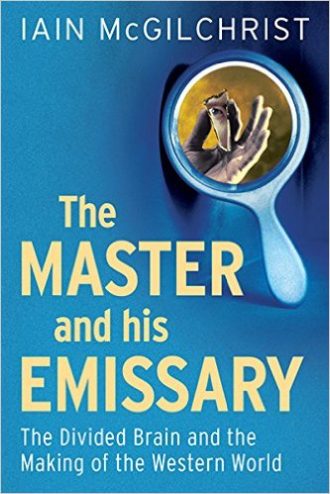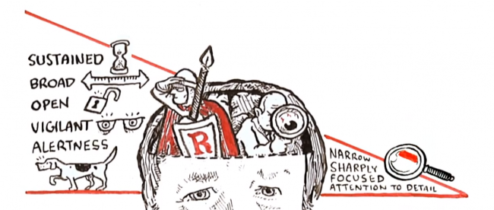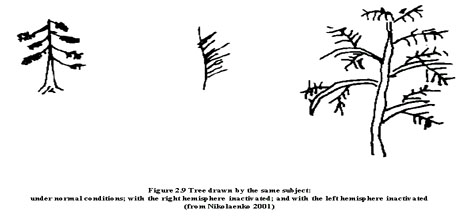Are you a right-brain or left-brain type of person? Is there such a thing? Are there differences between our left and right brain hemispheres? Does it matter?
Research into the left and right brain hemispheres was popularised in the 1970s, it exaggerated and reified the two sides of the brain as if some people were “right-brain” dominant: creative, image-based, intuitive, emotional; and other people were “left-brain” dominant: mathematical, language-based, logical.
Research has since found both sides of the brain are involved in creativity, both involved in language, logic, and mathematics – only that they are involved in different ways.
This said, it remains that our cortical hemispheres are asymmetrical; they not only look different, but they act and see the world in very different ways.
The left-brain puts its focus on the parts, narrows its vision in order to understand details, and use tools and objects for a predefined purpose.
The right-brain focuses on the whole, widening its vision to understand contexts, and keeping an open focus so to act without “an end in view”.
 Recent work in neuroscience, for example on stroke survivors and using new technologies that light up when different parts of the brain are being used, are illuminating this in exciting ways.
Recent work in neuroscience, for example on stroke survivors and using new technologies that light up when different parts of the brain are being used, are illuminating this in exciting ways.
The seminal work of Dr Iain McGilchrist in his book The Master and his Emissary: The Divided Brain and the Making of the Western World explores this new research and links it to the impact that different brain lateralisation functions, which are influenced by culture, impact the evolution of that culture. This has revolutionary implications both our personal experience of the world, and the way that we collectively impact the world.
I was honoured to meet Iain McGilchrist about a year ago, and I even got to have dinner sitting directly opposite from him and next to the brilliant Australian philosopher Arran Gare – whose work on process thought and the global ecological crisis my PhD is directly based on. (Another one of my nerdy-versions of sitting with the celebrities!)
McGilchrist posits uses recent findings of neuroscience to explore the differences between the hemispheres. He illuminates how the current relationship between the hemispheres has led to some of the most deeply-entrenched problems humanity is currently facing.
 First it is important to make clear, as McGilchrist does again and again that the idea that the left hemisphere gives us reason and language, while the right hemisphere gives us images and emotion is false: we need both hemispheres in order to deal with these things, from reason and emotions to interpreting language and images. McGilchrist writes: ‘every identifiable human activity is actually served at some level by both hemispheres’ (1).
First it is important to make clear, as McGilchrist does again and again that the idea that the left hemisphere gives us reason and language, while the right hemisphere gives us images and emotion is false: we need both hemispheres in order to deal with these things, from reason and emotions to interpreting language and images. McGilchrist writes: ‘every identifiable human activity is actually served at some level by both hemispheres’ (1).
The question is not what each hemisphere does, but in what way does it do it? The hemispheres do things in very different ways.
The primary difference is that the left hemisphere (LH) has a narrow focus, and the right hemisphere (RH) a broad focus.
The LH sees the parts, focuses on them, explores their details, operates in a targeted manner. We need our LH to coordinate our bodies, operate tools, and complete almost much any action. In order to do this, the LH carefully removes things from their contexts, dealing with ‘pieces of information in isolation.’ The RH on the other hand, ‘sees things in their context’ and deals with entities as a ‘whole, the so-called Gestalt’ (4).
Humans are not the only ones to have different brain lateralisation operations. McG uses the example of a bird who uses its LH to focus on a seed and operate its beak to open it. At the same time the bird uses its RH to be vigilant of predators, to engage in social interactions and so on.
 In this RSA 21st Century Enlightenment animation to McG’s TED Talk you can get a good introduction to these ideas:
In this RSA 21st Century Enlightenment animation to McG’s TED Talk you can get a good introduction to these ideas:
The key differences can be summarised as:

| Right Hemisphere (RH) | Left Hemisphere (LH) |
| Broad focus – emphasis on the interconnected whole | Narrow focus – emphasis on the separate parts |
| Big picture long-term view | Local short-term view |
| Parts are understood in context of their whole | De-contextualises parts, focus on specifics |
| Sees all as interconnected processes, always in flux | Sees all as comprised of separate static entities |
| Presents experience | Re-presents experience |
| Understands the whole first, believes the parts may only be understood in the context of the whole | Understands the parts, adding up this understanding to understand the whole |
| Builds provisional understandings, sees truth as a process, an ongoing quest without an end | Builds its understanding from a place of certainty |
| Interested what is new | Interested in what is known |
| Is boundless, open to potentiality and possibility | Works within boundaries, grasps within what has already been prioritised |
| Affinity with what is living, with what actually is | Affinity for the mechanical and artificial |
| Responsible for intersubjective processes such as self-awareness and empathy | Responsible for discriminating, making the separate parts clear and precise |
| Sees a net of interdependencies with deep connections | Sees fragmented separable entities grouped into classes |
| More responsibility for implicit reasoning such as problem solving | More responsibility for explicit reasoning such as logic |
| Understands indirect meanings such as metaphors, humour, sarcasm, etc | Relies on more direct and literal meanings and use of language |
| Favours individuality and uniqueness, works with specific examples, hence is more personal | Favours an anonymity, works with abstract categories and types – hence is more impersonal |
| Both/and approach – sees the cohesion between the LH and RH, integrates LH contributions | Either/or approach – sees LH and RH as in competition, and the RH to be unnecessary |
| Concerned with the “howness” of the process | Concerned with the “whatness” of things |
| Principally concerned with the intrinsic value of life | Principally concerned with utility / instrumental value of others |
| Integrates the self and body – sees the body as a living whole that is inseparable from our mind | Disconnects the self and body – sense of being the body’s “owner” and the body reducible to its parts |
| Sees the self as intrinsically inseparable from the world, in continuous relationship in space and time | Objectifies the self, sees the self as a separate entity, an expression of will |
| Accepts uncertainty and change, holds several possible truths together as tentative | Strives for certainty, needs to be right and interprets itself as right even when clearly wrong |
| Appreciates time as ongoing, an undivided flow, something lived through with past, present and future that is the context of all meaning in life | Breaks up time into units, measurable, as if a sequence of static points, separate momentary events |
| More realistic about how it stands in relation to the world at large, less grandiose, more self-aware | Ever optimistic, but unrealistic about its short-comings |
| Considers the whole as more than sum of its parts | Considers the whole to be the sum of its parts |
Note: this table contains near literal formulations from chapter 2 and 4 of McGilchrist (2009).
The Right Hemisphere as the Unifying Hemisphere
An important point that McG makes is that the RH sees the complementary nature of what the LH does, it enables it to do so and integrates LH knowledge into its big picture perspective. On the other hand, the LH sees the RH as a competitor, as a threat and as unnecessary to its more targeted and abstracted perspective.
McG extrapolates this from physical examples of the RH and LH interactions. For example he points out that the RH makes both eyes move together. Another example is that in split-brain patients the RH attends to the entire visual field while the LH attends only to the right visual field. Following a RH stroke, and is reliant only on the LH, they will see only the right side of their visual field – something called “hemi-neglect”. Drawings of such patients show that they fail to see the left side of a clock, a house, a cat, etc.
If on the other hand one has a LH stroke, and is reliant on only their RH, they will still see the full visual field and draw a full picture. For example these three figures were drawn by the same person – the first with both hemispheres, the second with only the LH (the RH was inactivated) and the third with only the RH (with the LH inactivated):

Why is this important?
We change the world by changing the way that we attend to it, by changing the type of attention we give it.
If we let our LH dominate over our RH, we may find ourselves narrowly-focused on abstracted aspects of our lives such as money, the future, the past, economic theories, technical details, and representations of experience, rather than the actual experience of life in each present moment. As a result we may feel alone, alienated from other people and from nature, anxious over what other people think about us and about our own mortality. Furthermore, under the rule of the LH we would act out of narrowly-defined self-interests, as our global economic framework assumes. This enables the perpetuation of structural forms of violence such as poverty and environmental destruction, for example as it leads people to purchase products based on price, creating demand for corporations to make profit regardless of the working conditions of offshore factory workers and environmental impact of both the production and consumption of these goods.
If we were to develop a more balanced-brain approach to using our LH and RH, we may find our lives change quite significantly for the better. With the LH and RH working together, we would use our RH’s conception of the world as a whole, integrating the detailed insights of the LH into that bigger picture.
Perhaps if we did this we might find ways of integrating the long-term, global happenings (for example, environmental destruction, perpetuation of inequality, and so on) with our individual actions. Maybe then we can support policy changes that regulate corporations, prices, and so on such that they prioritise people over profits…
Want to read more?
Read more in this short free PDF: Divided Brain, Divided World Or get the book, it’s no light read but it’s certainly rewarding!
Some time ago I wrote these two blog entries on similar issues:
[…] found a website which […]